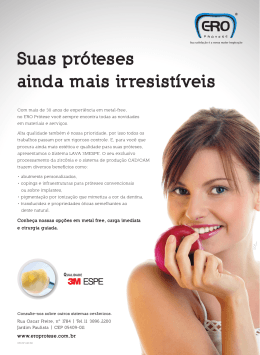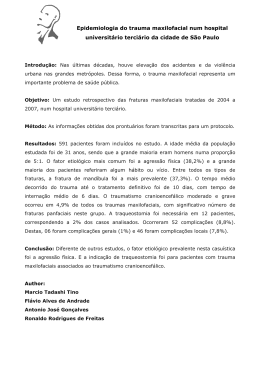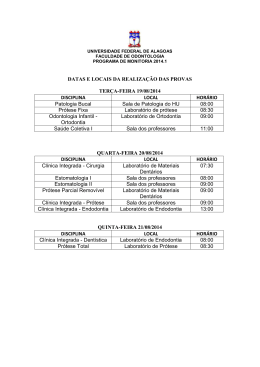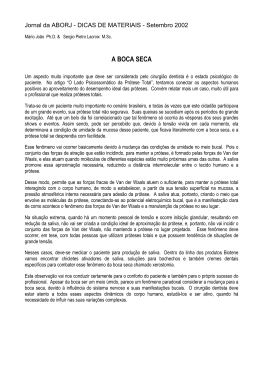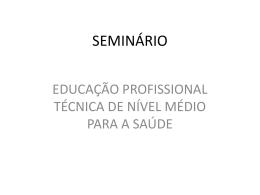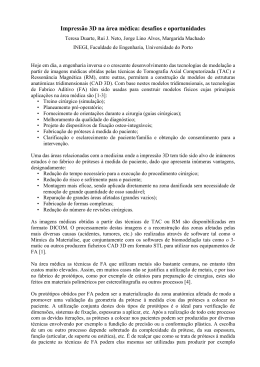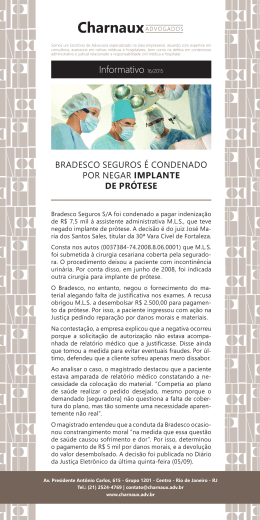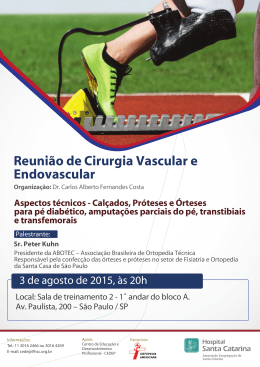Andréa Luana Oliveira Rosa Vexenat Perfil e análise da qualidade de vida dos pacientes portadores de próteses maxilofaciais Brasília 2014 Andréa Luana Oliveira Rosa Vexenat Perfil e nálise da qualidade de vida dos pacientes portadores de próteses maxilofaciais Trabalho de Conclusão de Curso apresentado ao Departamento de Odontologia da Faculdade de Ciências da Saúde da Universidade de Brasília, como requisito parcial para a conclusão do curso de Graduação em Odontologia. Orientadora: Profa. Dra. Aline Úrsula R. Fernandes Brasília 2014 À minha família, amigos e aos pacientes que se dispuseram a participar deste trabalho. AGRADECIMENTOS À Deus que é a razão do meu viver, pelo dom da vida e pela salvação através de Jesus Cristo. Aos meus pais, Ana de Cássia e Júlio Alejandro pelo amor incondicional e por sempre investirem em mim não medindo esforços para que eu chegasse a esta etapa da minha vida. Amo vocês. À minha professora e orientadora, Aline Úrsula pela paciência nа orientação е incentivo qυе tornaram possível а conclusão deste trabalho. Às minhas irmãs, Stephane, Alessandra, Isabella e Carina pelo amor, carinho e incentivo que sempre demonstraram. Aos meus sobrinhos, Daniel, Gabriel, Maria Clara, Davi, Matheus e Guilherme que fazem a minha vida mais feliz. Ao meu noivo Tiago pelo companheirismo e capacidade de me trazer paz nos momentos difíceis desta trajetória. Á minha dupla e amiga, Regina, pela paciência e convívio durante estes 5 anos de aprendizado, desafios, risadas, choros, caminhadas (literalmente), obrigada por fazer esse longo caminho ser mais divertido. EPÍGRAFE “Que os vossos esforços desafiem as impossibilidades, lembraivos de que as grandes coisas do homem foram conquistadas do que parecia impossível”. Charles Chaplin RESUMO VEXENAT, Andréa Luana Oliveira Rosa. Perfil e análise da qualidade de vida dos pacientes portadores de próteses maxilofaciais. 2014. Trabalho de Conclusão de Curso (Graduação em Odontologia) – Departamento de Odontologia da Faculdade de Ciências da Saúde da Universidade de Brasília. A especialidade de prótese maxilofacial tem como objetivo a reinserção do paciente no convívio social, restaurando partes da face ausentes ou malformadas, reestabelecendo a estética, atenuando deformidades congênitas ou adquiridas, tendo impacto direto na sua auto-estima. O objetivo do presente estudo foi relatar o perfil, relacionado ao uso de prótese maxilofacial, e a autopercepção da qualidade de vida dos pacientes com defeitos maxilofaciais, baseando-se nas últimas duas semanas anteriores à aplicação de questionários estruturados. Um total de 34 pacientes, atendidos no Hospital Universitário de Brasília, de ambos os gêneros e com idade acima de doze anos, foram convidados a participar do estudo. Os instrumentos utilizados foram um questionário de identificação do paciente, com informações sobre uso de próteses maxilofaciais e o formulário WHOQOL-Bref de auto-avaliação. Os dados foram tabulados e submetidos à análise estatística descritiva. Os resultados obtidos demonstraram que a etiologia mais comum das perdas oculares foi o trauma, enquanto para as perdas faciais mais extensas foi a congênita, e a causa bucal de defeito foi patologia. O maior acesso à reabilitação foi para prótese ocular estética, sendo instalada mais precocemente do que as demais. A retenção mecânica ainda supera os demais tipos de retenção das próteses. A percepção da qualidade de vida pelos pacientes, em todos os aspectos analisados, foi considerada boa. O atendimento em projeto de reabilitação dos defeitos maxilofaciais pode gerar a sensação de conforto e esperança aos seus portadores, da possibilidade de reinserção psicossocial. ABSTRACT VEXENAT, Andréa Luana Oliveira Rosa. Profile and analysis of quality of life of the patients with maxillofacial prostheses. 2014. Undergraduate Course Final Monograph (Undergraduate Course in Dentistry) – Department of Dentistry, School of Health Sciences, University of Brasília. The specialty of maxillofacial prosthesis aims to reintegrate the patient's social life, restoring parts of the face missing or malformed, reestablishing aesthetics, reducing congenital or acquired deformities, having a direct impact on your self-esteem. The aim of this study was to report the profile, related to the use of maxillofacial prosthesis, and self-perceived quality of life of patients with maxillofacial defects, based on the last two weeks prior to the application of structured questionnaires. A total of 34 patients treated at the University Hospital of Brasília, of both genders over the age of twelve, were invited to participate in the study. The instruments used were a questionnaire to identify the patient with information about use of maxillofacial prostheses and the WHOQOL-Bref form of self-evaluation. Data were tabulated and subjected to descriptive statistical analysis. The results showed that the most common cause of eye loss is trauma, while for the most extensive facial loss was congenital, and the defect was the cause of oral pathology. Greater access to rehabilitation for aesthetic prosthesis was being installed earlier than the others. The mechanical retention still outperforms other types of retention of dentures. The perception of quality of life for patients in all aspects analyzed, was considered good. The attention in the rehabilitation project of maxillofacial defects can generate a feeling of comfort and hope to their carriers, the possibility of psychosocial rehabilitation. SUMÁRIO Artigo Científico....................................................................... 17 Folha de Título......................................................................... 19 Resumo ................................................................................... 20 Abstract.................................................................................... 22 1 Introdução ............................................................................. 24 2 Proposição............................................................................ 25 3 Materiais e método ............................................................... 26 4 Resultados ............................................................................ 27 5 Discussão ............................................................................. 27 6 Conclusão ............................................................................. 30 7 Referências .......................................................................... 30 Elementos gráficos ................................................................. 33 Anexos ................................................................................... 38 A. Normas da Revista ............................................................. 39 B. Questionário WHOQOL- Bref ............................................. 50 C. Termo de Consentimento livre e esclarecido ..................... 56 D. Aprovação pelo Comitê de Ética em Pesquisa .................. 58 E. Tabelas para estatística descritiva ..................................... 59 16 17 ARTIGO CIENTÍFICO Este trabalho de Conclusão de Curso é baseado no artigo científico: Vexenat, ALOR; Lima, RPS; Lima, JGS; Fernandes, PL; Fernandes, AÚRF. Perfil e análise da qualidade de vida dos pacientes portadores de próteses maxilofaciais. Apresentado sob as normas de publicação do Journal of Prosthodontics 18 19 FOLHA DE T ÍTULO Perfil e análise da qualidade de vida dos pacientes portadores de próteses maxilofaciais Profile and analysis of the quality of life of patients with maxillofacial prostheses Andréa Luana Rosa Oliveira Vexenat1 Richard Presley Silva Lima1 João Guilherme de Sena Lima1 Patrice Lopes Fernandes1 Aline Úrsula Rocha Fernandes2 1 Aluno de Graduação em Odontologia da Universidade de Brasília. 2 Professora Adjunto de Prótese Dentária da Universidade de Brasília (UnB). Correspondência: Profa. Dra. Aline Úrsula Rocha Fernandes Campus Universitário Darcy Ribeiro - UnB - Faculdade de Ciências da Saúde - Departamento de Odontologia - 70910-900 Asa Norte - Brasília - DF E-mail: [email protected] / Telefone: (61) 31071811 20 RESUMO Perfil e análise da qualidade de vida dos pacientes portadores de próteses maxilofaciais Resumo A especialidade de prótese maxilofacial tem como objetivo a reinserção do paciente no convívio social, restaurando partes da face ausentes ou malformadas, reestabelecendo a estética, atenuando deformidades congênitas ou adquiridas, tendo impacto direto na sua auto-estima. O objetivo do presente estudo foi relatar o perfil, relacionado ao uso de prótese maxilofacial, e a autopercepção da qualidade de vida dos pacientes com defeitos maxilofaciais, baseando-se nas últimas duas semanas anteriores à aplicação de questionários estruturados. Um total de 34 pacientes, atendidos no Hospital Universitário de Brasília, de ambos os gêneros e com idade acima de doze anos, foram convidados a participar do estudo. Os instrumentos utilizados foram um questionário de identificação do paciente, com informações sobre uso de próteses maxilofaciais e o formulário WHOQOL-Bref de auto-avaliação. Os dados foram tabulados e submetidos à análise estatística descritiva. Os resultados obtidos demonstraram que a etiologia mais comum das perdas oculares foi o trauma, enquanto para as perdas faciais mais extensas foi a congênita, e a causa bucal de defeito foi patologia. O maior acesso à reabilitação foi para prótese ocular estética, sendo instalada mais precocemente do que as demais. A retenção mecânica ainda supera os demais tipos de retenção das próteses. A percepção da qualidade de vida pelos pacientes, em todos os aspectos analisados, foi considerada boa. O atendimento em projeto de reabilitação dos defeitos maxilofaciais pode gerar a sensação de conforto e esperança aos seus portadores, da possibilidade de reinserção psicossocial. Palavras-chave Prótese maxilofacial, Reabilitação, Qualidade de vida 21 Relevância Clínica A análise da qualidade de vida e do perfil dos pacientes com defeitos maxilofaciais permite aprimorar a reabillitação dos mesmos, com ênfase na reinserção social e bem estar psicológico. 22 ABSTRACT Profile and analysis of the quality of life of patients with maxillofacial prostheses Abstract The specialty of maxillofacial prosthesis aims to reintegrate the patient's social life, restoring parts of the face missing or malformed, reestablishing aesthetics, reducing congenital or acquired deformities, having a direct impact on your self-esteem. The aim of this study was to report the profile, related to the use of maxillofacial prosthesis, and self-perceived quality of life of patients with maxillofacial defects, based on the last two weeks prior to the application of structured questionnaires. A total of 34 patients treated at the University Hospital of Brasília, of both genders over the age of twelve, were invited to participate in the study. The instruments used were a questionnaire to identify the patient with information about use of maxillofacial prostheses and the WHOQOL-Bref form of self-evaluation. Data were tabulated and subjected to descriptive statistical analysis. The results showed that the most common cause of eye loss is trauma, while for the most extensive facial loss was congenital, and the defect was the cause of oral pathology. Greater access to rehabilitation for aesthetic prosthesis was being installed earlier than the others. The mechanical retention still outperforms other types of retention of dentures. The perception of quality of life for patients in all aspects analyzed, was considered good. The attention in the rehabilitation project of maxillofacial defects can generate a feeling of comfort and hope to their carriers, the possibility of psychosocial rehabilitation. 23 Keywords Maxillofacial prosthesis, Rehabilitation, Quality of life 24 1.INTRODUÇÃO A importância da qualidade de vida é reconhecida para o sucesso de todo tratamento reabilitador. Ao longo dos anos, diversos estudos têm sido realizados1,2,3,4,5, com diferentes instrumentos de análise, para determinar a autopercepção dos pacientes quanto ao tema. Os defeitos faciais podem ocorrer por traumas, doenças congênitas e cirurgias para remoção de tumores, podendo alterar a fala, a qualidade de vida, o estado psicológico do paciente e o seu comportamento social6,7. A qualidade de vida de pacientes com defeitos maxilofaciais é geralmente comprometida, mesmo quando uma reconstrução cirúrgica ou prótese é instalada. Os defeitos podem ser reparados com técnicas cirúrgicas ou por meio dispositivos protéticos, dependendo do local, tamanho, idade, etiologia e gravidade, e da preferência do doente. A reconstrução cirúrgica pode ser limitada pela idade, estado de saúde geral do paciente, tecido residual insuficiente, necessidade de acompanhamento na recorrência de tumores, comprometimento vascular subseqüente à radiação, a inadequação dos locais de doação, ou preferência do paciente. Nessas situações, a reabilitação protética torna-se o tratamento preferido1. Próteses faciais são importantes não somente na reabilitação e estética, mas também na socialização do paciente. O nível de reintegração está diretamente relacionado com o grau de satisfação com a reabilitação. Assim, as próteses maxilofaciais devem fornecer a satisfação ao paciente durante o tratamento8. Existem vários tipos de próteses maxilofaciais, sendo mais frequentes as próteses: oculares, óculos-palpebrais, nasais, auriculares e obturadoras. Elas permanecem em posição através de adesivos químicos, retenções anatômicas e sistemas associados a implantes osseointegrados. As consequências psicossociais, devido a enfermidades ou deformações, vêm direcionando várias especialidades para o estudo da qualidade de vida dos pacientes. Tal estudo facilita o direcionamento dos centros de atendimento, para protegê-los de problemas físicos e psicológicos e para monitorar o progresso ao longo do tempo9, 10. Todos os pacientes com câncer enfrentam mudanças psicológicas consideráveis2, pois, além do medo e da 25 possibilidade de morte, a vida dos mesmos torna-se limitada pelas deformidades causadas pela ressecção do tumor3. Quando o defeito encontra-se na região de cabeça e pescoço, proporciona um impacto talvez maior do que se fosse em outra região do corpo. Existem numerosos estudos sobre qualidade de vida, com desenvolvimento de questionários específicos, relacionados à pacientes portadores de câncer de cabeça e pescoço, inclusive com perdas de parte de estruturas3. Estudos da mudança na percepção da qualidade de vida após reabilitação protética maxilofacial são limitados11, 12. Devido à complexidade do assunto, escassez da literatura específica e polêmica do tema13, este estudo utilizará dois instrumentos de obtenção de informações: a respeito do perfil de pacientes quanto às próteses maxilofaciais reabilitadoras e uma medida genérica (WHOQOL–Bref), desenvolvida pelo Grupo de Qualidade de vida da Organização Mundial de Saúde, que avalia a qualidade de vida em uma perspectiva internacional 14. O WHOQOL-Bref está disponível em 20 idiomas. No Brasil, a versão em português foi desenvolvida no Departamento de Psiquiatria e Medicina legal da Universidade Federal do Rio Grande do Sul (UFRGS), tendo como coordenador o Dr. Marcelo Pio de Almeida Fleck14. Essa proposta de trabalho visa conhecer o perfil, as necessidades e as expectativas do portador de prótese maxilofacial, a fim de contribuir para uma melhor intervenção técnica e reintegração social do paciente. 2. PROPOSIÇÃO O objetivo deste estudo foi explorar informações para conhecer o perfil, relacionado diretamente ao defeito e uso da prótese, dos pacientes com defeitos maxilofaciais, reabilitados ou em tratamento reabilitador maxilofacial, no Hospital Universitário de Brasília, e da autopercepção dos mesmos quanto à qualidade de vida, nas últimas duas semanas anteriores à aplicação de questionários estruturados. 26 3. MATERIAL E MÉTODO Este trabalho foi submetido ao Comitê de Ética em Pesquisa em Seres Humanos da Faculdade de Medicina da Universidade de Brasília, sendo aprovado sob o número 038/2011. A pesquisa foi realizada através de um estudo transversal qualitativo analítico, na Clínica de Odontologia do Hospital Universitário de Brasília, com os pacientes reabilitados por próteses maxilofaciais, desde 2004, quando o serviço foi implantado. Um total de 50 pacientes, de ambos os gêneros e com idade acima de doze anos, foram convidados a participar do estudo. Daqueles, 34 voluntários foram avaliados. Os demais não compareceram à entrevista. Foi realizada busca nos prontuários odontológicos na Divisão de Odontologia do HUB, para identificar os pacientes reabilitados com essas próteses, além daqueles em tratamento reabilitador. As entrevistas ocorreram nos dias de funcionamento do serviço de prótese maxilofacial no HUB. A coleta dos dados foi realizada pelos pesquisadores e envolveu as seguintes fontes de informação: formulários estruturados com perguntas dirigidas para definir o perfil da amostra (Questionário de Identificação do Paciente, acrescido de dados relativos à prótese maxilofacial) e aplicação do formulário WHOQOL-Bref de auto-avaliação, que é auto-explicativo. Todas as normas de procedimentos de aplicação do WHOQOL-Bref14 foram respeitadas. O módulo WHOQOL-BREF é constituído de 26 perguntas, sendo as perguntas 1 e 2 sobre a qualidade de vida geral. As respostas seguem uma escala de Likert de 1 a 5, quanto maior a pontuação melhor a qualidade de vida. Fora essas duas questões (1 e 2), o instrumento tem 24 facetas as quais compõem 4 domínios que são: FÍSICO, PSICOLÓGICO, RELAÇÕES SOCIAIS e MEIO AMBIENTE (conforme especificado no Quadro 1). A análise estatística foi realizada através de técnicas de estatística descritiva, utilizando distribuição de freqüências, percentuais, medidas estatísticas, gráficos ilustrativos. A análise do WHOQOL-Bref teve a pontuação dos escores realizada utilizando o programa estatístico SPSS, com a sintaxe do WHOQOL-bref15. 27 4. RESULTADOS Os resultados obtidos, após análise estatística descritiva, estão apresentados no Quadro 2 e representados nos Gráficos 1 e 2. A avaliação do perfil dos pacientes foi separada por tipo de defeito maxilofacial (ocular, facial e bucal), obtendo os resultados apresentados no Quadro 3. 5. DISCUSSÃO Nos últimos anos, tem havido um crescente interesse no uso de relatos vindos de pacientes para facilitar o cuidado centrado no paciente, na triagem de problemas físicos e psicológicos e para monitorar o progresso do mesmo ao longo do tempo5,6. A deformidade facial atinge o ser humano em todos os seus aspectos de vida: psicológico, social, físico. A forma como o indivíduo enfrenta os desafios gerados por essa situação implica em sua percepção de qualidade de vida. A percepção do paciente sob tratamento com prótese facial é elemento importante para a avaliação da qualidade do atendimento, porque medir os resultados dos pacientes tais como qualidade de vida relacionada com a saúde, na prática clínica, pode fornecer informações importantes para o planejamento e melhor reabilitação protética maxilofacial 8. Pacientes com defeitos faciais podem expressar insatisfação com a imagem corporal, muitas vezes levando à baixa auto-estima, sintomas de transtorno de estresse pós-traumático e isolamento social provocado pelo estigma5,6,7. Uma pesquisa realizada, avaliando pacientes portadores de próteses maxilofaciais retidas com implante, revelou um aumento na qualidade de vida dos pacientes após o uso, sendo considerada altamente satisfatória1. Outro estudo demonstrou que a qualidade de vida em pacientes que se submeteram à reconstrução com próteses obturadoras, após maxilectomia, obteve uma melhora significativa, porém, o estudo relata que o contexto de vida em que a doença e o tratamento ocorreram também são poderosos determinantes dessa condição2. 28 Pacientes que fazem uso de próteses maxilofaciais foram comparados com um grupo controle e o resultado apresentado demonstrou que o primeiro grupo teve menor pontuação em qualidade de vida geral, domínios de saúde física e ambientais do que os do grupo de controle5. Baseado em uma pesquisa que avalia o psicossocial e a qualidade de vida na reabilitação protética auricular com CAD/CAM, Os resultados preliminares mostram que há uma redução dos sintomas depressivos após a operação. Além disso, as emoções positivas em termos de nível de felicidade também tendem a melhorar após a operação. Isto sugere que a melhora na aparência facial é benéfico para o humor dos pacientes 4. Tendo como base as pesquisas citadas e através do presente estudo, podemos constatar que apesar das dificuldades que pacientes portadores de próteses maxilofaciais ou em fase de reabilitação enfrentam ao longo da vida, principalmente na área psicossocial, é possível que o paciente tenha momentos de conforto em suas vidas. Isso pode ser demonstrado nos resultados apresentados nos Gráficos 1 e 2. No Gráfico 1, temos que todos os Domínios (Físico, Psicológico, Relações Sociais e Meio ambiente) tiveram um índice de satisfação acima de 50%; no Gráfico 2, que expõe as 24 facetas que compõe os 4 Domínios, a maioria obtiveram um índice de satisfação acima de 50%. O desvio padrão, presente na análise estatística descritiva (Quadro 2), demonstra que não houve divergência significativa em relação à percepção dos entrevistados em relação aos Domínios abordados no questionário. Analisando o perfil dos pacientes que participaram da pesquisa, de acordo com as informações obtidas pelo Questionário de Identificação do Paciente (Quadro 3), observamos que 64,7% dos pacientes atendidos no serviço de próteses maxilofaciais, avaliados neste estudo, foram reabilitados por próteses oculares. Deste grupo, a etiologia do defeito com maior prevalência foi o trauma (68,18%). Quando analisada a etiologia para perda de outras estruturas faciais e bucais, a congênita torna-se a mais prevalente, não sendo obtido nenhum caso de trauma. Foi constatado também que 100% dos entrevistados portadores de próteses oculares e bucais fazem uso de retenção anatômica. Tal fato pode ser explicado pela existência, nessas áreas, de cavidades que, por si só, podem fornecer a retenção adequada. Em contrapartida, próteses faciais, como auriculares, nasais e 29 óculo-palpebrais, comumente necessitam ser instaladas por meio de adesivo ou sobre implantes. Apesar de estudos afirmarem que a técnica por meio de retenção adesiva não foi bem tolerada devido ao incômodo, dificuldade de retenção devido à ineficácia dos adesivos químicos, inflamação da pele, e da corrosão da prótese devido sua composição química4,16, 77% dos pacientes que fazem uso de próteses faciais utilizam a retenção adesiva. A necessidade de troca da prótese ao longo da vida teve taxa expressiva nos três tipos. No caso da prótese ocular, o motivo variou entre desgaste, aumento da cavidade ou ambos. A prótese ocular, feita de resina, tem vida útil por volta de 5 anos. Após esse tempo, a resina acrílica apresenta deterioração, podendo irritar a cavidade anoftálmica, o que leva à troca. Outros pacientes são submetidos ao tratamento protético muito cedo, quando crianças ainda. Por isso, como a prótese também estimula o crescimento da cavidade, o olho artificial tem a necessidade de ser trocado, visto que se encontra menor que a cavidade, em pouco tempo. A prótese facial apresentou a descoloração como principal motivo de troca, pois o silicone, material com o qual é confeccionada, com o passar do tempo, sofre este efeito indesejável. No caso das próteses bucais, as razões que levaram os pacientes a desejarem uma nova foi o fato de não apresentarem uma boa retenção na cavidade, devido ao tempo de uso e em uma delas o paciente demonstrou insatisfação com alguns dentes fraturados. A grande maioria dos pacientes avaliados (Quadro 3), independente do defeito maxilofacial que portava, apresentou tempo de espera para obtenção da reabilitação superior a um ano. A demora na reabilitação pode explicar a necessidade de atendimento especializado, maior divulgação e formação de equipes multiprofissionais, para atendimento de pacientes com defeitos maxilofaciais. Apesar de um resultado de pesquisa satisfatório deve-se levar em consideração que uma pesquisa feita com o uso de questionários pode gerar algumas limitações como alterações no comportamento do entrevistado devido à presença do pesquisador, o humor do paciente no dia da entrevista, a forma como o pesquisador faz a pergunta pode direcionar um tipo de resposta e a não garantia de que o que está sendo respondido de fato é a realidade. 30 A pesquisa não ofereceu nenhum tipo de risco, pois somente foram coletados dados durante consultas de retorno, rotina para verificar adaptação da prótese e conforto do paciente. Como benefícios, os pacientes puderam ser mais uma vez esclarecidos quanto à utilização da prótese em situações do cotidiano e orientações para o bom uso. Os profissionais envolvidos no processo de reabilitação, como o cirurgião-dentista, poderão contar com dados que os auxiliem na melhor compreensão do processo de reabilitação, de forma a estruturar programas que facilitem a adaptação dos pacientes em reabilitação. A divulgação dos resultados em eventos científicos e junto aos profissionais envolvidos no cuidado destes pacientes poderá resultar em melhor planejamento dos serviços disponíveis. 6. CONCLUSÃO Apesar da dificuldade de acesso ao tratamento e da demora em alcançar a reabilitação, especialmente para os pacientes com defeitos congênitos, a percepção dos pacientes avaliados quanto à qualidade de suas vidas não demonstrou interferências, dentro de uma análise geral. O atendimento em projeto de reabilitação dos defeitos maxilofaciais pode gerar a sensação de conforto e esperança aos seus portadores, da possibilidade de reinserção psicossocial. 7. REFERÊNCIAS 1- Nemli SK, Aydin C, Yilmaz H, et al: Quality of life of patients with implant-retained maxillofacial prostheses: a prospective and retrospective study, J Prosthet Dent, 2013 Jan; 109(1):44-52. 2- Irish J, Sandhu N, Simpson C, Wood R, et al: Quality of life in patients with maxillectomy prostheses. Head Neck 2009, 31: 813–821. doi: 10.1002/hed.2104 31 3- Morimata J, Otomaru T, Murase M, et al: Investigation of factor affecting health-related quality of life in head and neck cancer patients. Gerodontology, 2013 30: 194–200. doi: 10.1111/j.1741-2358.2012.00662.x 4- Tam CK, McGrath CP, Ho SM et al: Psychosocial and quality of life outcomes of prosthetic auricular rehabilitation with CAD/CAM technology. Int J Dent. 2014:393571. doi: 10.1155/2014/393571 5- Atay A, Peker K, Günay Y, et al: Assessment of healthrelated quality of life in Turkish patients with facial prostheses. Health Qual Life Outcomes. 2013 Jan 26;11:11. doi: 10.1186/1477-7525-11-11. 6- Lim SY, Lee D, Oh KS, et al: Concealment, depression and poor quality of life in patients with congenital facial anomalies. J Plast Reconstr Aesth Surg 2010, 63:1982– 1989. . 7- .De Sousa A: Psychological issues in acquired facial trauma. Indian J Plast Surg 2010, 43:200–205. 8- Goiato MC, Pesqueira A.A, Ramos da Silva C, et al: Patient satisfaction with maxillofacial prosthesis. Literature review. J Plast Reconstr Aesthet Surg 2009, 62:175–180. 9- Lohr KN, Zebrack BJ: Using patient-reported outcomes in clinical practice: challenges and opportunities. Qual Life Res 2009, 18:99–107. 10- Snyder CF, Aaronson NK, Choucair AK, et al: Implementing patient-reported outcomes assessment in clinical practice: a review of the options and considerations. Qual Life Res 2012, 21:1305–1314. 11- Schoen PJ, Raghoebar GM, van Oort RP, et al: Treatment outcome of bone-anchored craniofacial prostheses after tumor surgery. Cancer 2001;92:3045-50. 32 12- Chang TL, Garrett N, Roumanas E, et al: Satisfaction with facial prostheses. J Prosthet Dent 2005;94:275-80. 13- Nicodemo D, Ferreira LM: Formulário do perfil psicossocial do paciente anoftálmico com indicação de prótese ocular. Arq. Bras.Oftalmol 2006; 69,4 14- FAMED – UNIVERSIDADE FEDERAL DO RIO GRANDE DO SUL/HCPA. (1998) Versão em português dos instrumentos de avaliação de qualidade de vida (WHOQOL). Disponível em: < http://www.ufrgs.br/psiq/WHOQOL.html> Acesso em: 28 abr. 2011. 15- Pedroso B, Pilatti LA, Gutierrez GL, et al: Cálculo dos Escores e Estatística Descritiva do WHOQOL-bref através do Microsoft Excel. Revista Brasileira de Qualidade de Vida. V.02, n.01, Jan./jun. 2010, p. 31-36; Ponta Grossa – PR – Brasil. 16- N. I. Elsahy: Acquired ear defects. Clinics in Plastic Surgery, vol. 29, no. 2, pp. 175–186, 2002. 17- Leonardi A, Buonaccorsi S, Pellacchia V, et al: Maxillofacial prosthetic rehabilitation using extraoral implants. J Craniofac Surg 2008, 19:398–405. 18- Dostalova T, Kozak J, Hubacek M, et al: Facial Prosthesis. In Implant Dentistry - A Rapidly Evolving Practice. Edited by Turkyilmaz I. Croatia: InTech; 2011:451–464. 33 ELEMENTOS GRÁFICOS Quadro 1 - Domínios e facetas do WHOQOL-bref DOMÍNIOS Domínio I – Domínio físico Domínio II – Domínio psicológico Domínio III – Relações sociais Domínio IV – Meio ambiente Fonte: The WHOQOL Group (1998) FACETAS 1. Dor e desconforto 2. Eneria e fadiga 3. Sono e repouso 4. Mobilidade 5. Atividades de vida cotidiana 6. Dependência de medicação ou de tratamentos 7. Capacidade de trabalho 8. Sentimentos positivos 9. Pensar, aprender, memória e concentração 10. Auto-estima 11. Imagem corporal e aparência 12. Sentimentos negativos 13. Espiritualidade/religião/crenças pessoais 14. Relações pessoais 15. Suporte (apoio) social 16. Atividade sexual 17. Segurança física e proteção 18. Ambiente no lar 19. Recursos financeiros 20. Cuidados de saúde e sociais: disponibilidade e qualidade 21. Oportunidades de adquirir novas informações e habilidades 22. Participação em e oportunidades de recreação e lazer 23. Ambiente físico (poluição/ruído/trânsito/clima) 24. Transporte 34 Quadro 2 – Análise estatística descritiva dos dados obtidos por meio dos questionários autoexplicativos de qualidade de vida (WHOQOL-Bref) DOMÍNIO MÉDIA DESVIO PADRÃO COEF DE VARIAÇÃO VALOR MÍNIMO VALOR MÁXIMO AMPL Físico 14,59 2,49 17,04 8,57 19,43 10,86 Psicológico Relações Sociais Meio Ambiente Auto-avaliação da QV TOTAL 14,80 2,10 14,19 8,00 18,00 10,00 16,67 2,87 17,20 9,33 20,00 10,67 12,44 2,30 18,48 7,00 16,50 9,50 15,59 2,40 15,40 8,00 20,00 12,00 14,28 1,66 11,64 10,46 18,08 7,62 35 Gráfico 1 – Porcentagem de resultados positivos, dentro de cada domínio avaliado 36 Gráfico 2 – Resultados, em porcentagem, de acordo com facetas analisadas 37 Quadro 3 – Perfil dos pacientes portadores de defeitos maxilofaciais, quanto às próteses reabilitadoras Tipo de defeito maxilofacial Número de pacientes Etiologia do defeito (quantidade de pacientes) Início de uso da prótese reabilitadora, após a perda de estrutura* Tipo de retenção da prótese** Necessidade de troca de prótese reabilitadora, ao longo da vida*** Trauma Congênita Patologia Após 40 anos Entre 30 e 39 anos Entre 20 e 29 anos Entre 10 e 19 anos Entre 1 e 9 anos Mesmo ano Mecânica Adesiva Sobre implantes Sim Não Ocular 22 15 0 7 Facial 9 0 7 2 Bucal 3 0 1 2 4,76% 11% 33% 19,04% 11% 0% 14,28% 0% 0% 19,04% 0% 0% 19,4% 11% 33% 23,8% 100% 0% 0% 0% 77% 33% 100% 0% 0% 33% 0% 40,9% 45% 100% 59,1% 55% 0% *Relativo ao total da amostra. A soma da porcentagem equivale ao total de usuários **Relativo somente aos que já utilizam próteses ***Não necessidade de troca corresponde a não usar prótese ou ter recentemente instalado 38 39 ANEXOS A. NORMAS DA REVISTA Author Guidelines Instructions to contributors Editorial office contact information David A. Felton, DDS, MS, FACP Editor-in-Chief West Virginia University School of Dentistry Robert C. Byrd Health Sciences Center PO Box 9400 Morgantown, WV 26506-9400 304-293-1000 E-mail: [email protected] Authors submitting a paper do so on the understanding that the work has not been published before, is not being considered for publication elsewhere and has been read and approved by all authors. The work shall not be published elsewhere in any language without the written consent of the publisher. The articles published in this journal are protected by copyright, which covers translation rights and the exclusive right to reproduce and distribute all of the articles printed in the journal. No material published in the journal may be stored on microfilm or videocassettes or in electronic databases and the like or 40 reproduced photographically without the prior written permission of the publisher. Submission of Manuscripts Submission of Manuscripts Submit through our online submission and review site at http://mc.manuscriptcentral.com/jopr. Create an account, and upload the body of your manuscript. You will also be able to upload any digital figures associated with the manuscript. You will be able to track the progress of your manuscript through the peer review process. A Users Guide and online tutorial are available by clicking the “Get Help Now” link. All Journal of Prosthodontics forms and instructions are also available at the site. If you have any questions, please contact Alethea Gerding at [email protected]. Please note: the Journal of Prosthodontics will no longer review the following manuscripts: 1) Those testing groups with sample sizes less than 10 per group, unless the manuscript also includes a power calculation to determine the small group's statistical validity, or if the manuscript includes a justification for the smaller sample size (i.e., citations to similar studies also using small sample sizes). 2) 2D FEA studies, unless a strong case can be made that the study cannot be conducted via 3D FEA. Title page - The title page should contain the following information in the order given: 1) Full title of manuscript. 2) Authors' full names. 3) Authors' institutional affiliations including city and country. 4) A running title, not exceeding 60 letters and spaces. 5) The name and address of the author responsible for correspondence about the manuscript. If the work has previously been presented, the name, place, and date of meeting(s) must be given. If any financial support was 41 received, the grant/contract number, sponsor name, and city, state, and country location must be supplied. Abstract page – An abstract is required for all manuscripts and must precede the body of the manuscript. Abbreviations and references should not appear in the abstract. Research manuscripts must conform to the Structured Abstract format. Structured Abstracts should not exceed 350 words and must contain the following information: (1) Purpose (2) Materials and Methods (3) Results (4) Conclusions Clinical reports and Techniques and Technology manuscripts do not need a structured abstract. Following the abstract and on the same page, there should be several words not appearing in the title of the manuscript to be titled: KEYWORDS. Text – Research manuscripts should include the following sections: Introduction, Materials and Methods, Results, Discussion, Conclusion, Acknowledgements, and References. Experimental design should be clearly described (eg, randomized clinical trial, cohort study, case-control study, case series). Other manuscripts should begin with an introductory paragraph of at least two to five sentences. The remainder of the manuscript should be divided into sections preceded by appropriate headings. The Introduction will include the following: a description of the problem that inspired the study; a brief discussion of relevant published material that addressed the same problem or that documents methodology used in the study; and the goal of the study, the purpose statement or hypothesis. 42 The Materials and Methods section describes materials or subjects used and the methods selected to evaluate them, including information about the overall design, the nature of the sample studied, the type of interventions (or treatments) applied to the individual elements in the sample, and the principal outcome measure. Statistical methodology should be included in this section. Please note: All human subject research (including surveys) must include a statement of ethical or institutional review board approval. Please note: For research reports, we require a minimum of ten (10) specimens per experimental group UNLESS a power calculation has been performed by a statistician to demonstrate that the sample size is capable of providing statistical significance. Or UNLESS the manuscript includes a justification for the smaller sample size (i.e., citations to similar studies also using small sample sizes). The Results section will be a clear statement of the findings and an evaluation of their validity based on the outcome of statistical tests. The Discussion section presents the research in its broader context, describes its clinical implications, identifies limitations or problems that emerged during the course of the study, characterizes the larger significance of the findings, and articulates any further questions remaining to be answered on the subject. The Conclusion section includes only a brief and succinct summary of the findings. 43 References - Number references consecutively in the order in which they are first mentioned in the text. Identify references in texts, tables, and legends by superscript Arabic numerals. Use the style of the examples below, which are based on the format used by the US National Library of Medicine in Index Medicus. For abbreviations of journals, consult the 'List of the Journals Indexed' printed annually in the January issue of Index Medicus. For standard journal articles list all authors when three or fewer; when three or more, list first three authors and add et al. Example: Raghoebar GM, Brouwer TJ, Reintesma H, et al: Augmentation of the maxillary sinus floor of autogenous bone for the placement of endosseous implants: A preliminary report. J Oral Maxillofac Surg 1993;51:1198-1203 Chapter in book Phoenix, RD: Denture base resins: Technical considerations and processing techniques, in Anusavice KJ (ed): Phillips’ Science of Dental Materials, vol 1 (ed 10). Philadelphia, PA, Saunders, 1996, pp 237-271 Tables – Tables should be positioned following the references, not in the body of the manuscript. The tables should be numbered consecutively with Arabic numerals. Each table should be typed on a separate sheet. Include any necessary legends on the same page with the associated table. Illustrations – All graphs, drawings, and photographs are considered figures and should be numbered in sequence with Arabic numerals. Each figure should have a legend and all legends should be typed together on a separate sheet and numbered correspondingly. 44 The inclusion of color illustrations is at the discretion of the editor. Details must be large enough to retain their clarity after reduction in size. Micrographs should be designed to be reproduced without reduction, and they should be dressed directly on the micrograph with a linear size scale, arrows, and other designators as needed. Figures submitted to the Journal of Prosthodontics Photographs of People The Journal of Prosthodontics follows current HIPAA guidelines for the protection of patient/subject privacy. If an individual pictured in a digital image or photograph can be identified, his or her permission is required to publish the image. The corresponding author may submit a letter signed by the patient authorizing the Journal of Prosthodontics to publish the image/photo. Or, a form provided by theJournal of Prosthodontics (available by clicking the “Instructions and Forms” link in ScholaOne Manuscripts) may be downloaded for your use. This approval must be received by the Editorial Office prior to final acceptance of the manuscript for publication. Otherwise, the image/photo must be altered such that the individual cannot be identified (black bars over eyes, etc). Manipulation of Digital Photos Authors should be aware that the Journal considers digital images to be data. Hence, digital images submitted should contain the same data as the original image captured. Any manipulation using graphical software should be identified in either the Methods section or the caption of the photo itself. Identification of manipulation should include both the name of the software and the techniques used to enhance or change the graphic in any way. Such a disclaimer ensures that the methods are repeatable and ensures the scientific integrity of the work. No specific feature within an image may be enhanced, obscured, moved, removed, or introduced. The grouping of images from 45 different SEMS, different teeth, or the mouths of different patients must be made explicit by the arrangement of the figure (i.e., by using dividing lines) and in the text of the figure legend. Adjustments of brightness, contrast, or color balance are acceptable if they are applied to the whole image and as long as they do not obscure, eliminate, or misrepresent any information present in the original, including backgrounds. The removal of artifacts or any non-integral data held in the image is not allowed. For instance, removal of papillae or “cleaning up” of saliva bubbles is not allowed. Cases of deliberate misrepresentation of data will result in rejection of a manuscript, or if the misrepresentation is discovered after a manuscript’s acceptance, revocation of acceptance, and the incident will be reported to the corresponding author's home institution or funding agency. Letters to the Editor - Letters to the editor of the Journal of Prosthodontics are welcomed. You may submit through our online submission site (http://mc.manuscriptcentral.com/jopr) or email directly to the editor-in-chief at [email protected]. While we will read and respond to all letters, we will only publish a select few. We are most likely to publish letters that deal with a controversial topic or that take issue with research published in theJournal of Prosthodontics. While a letter may be critical, in order to be considered for publication, it must not be insulting. Criticism should be constructive, and arguments made should be appropriately referenced to previously published work. Upon approval for publication, we will publish the letter in the next available print issue of theJournal of Prosthodontics. When written in response to an article published in the Journal, we will also give the author of the original article the opportunity to 46 respond. If they choose to do so, we will attempt to publish the letter and response in the same issue. Abbreviations, symbols and nomenclature – Authors are to use current prosthodontic nomenclature and are referred to the Glossary of Prosthodontic Terms (8th Edition) for accepted terminology. Generic names should be used for all drugs and equipment. When a trade name must be used, cite parenthetically the trade name and the name, city, state, and country of the manufacturer. Measurements should be in the metric system. Permissions – Any illustrations or tables that have been published previously must be accompanied by a letter of permission from the copyright holder (usually the publisher). Illustrations or tables that have been adapted or modified must also be accompanied by letters of permission. Copyright – Authors will be required to fill out a copyright assignment form prior to their articles being published. The form can be found here. For authors signing current licensing/copyright agreement Note to Contributors on Deposit of Accepted Version Funder arrangements Certain funders, including the NIH, members of the Research Councils UK (RCUK) and Wellcome Trust require deposit of the Accepted Version in a repository after an embargo period. Details of funding arrangements are set out at the following website:http://www.wiley.com/go/funderstatement. Please contact the Journal production editor if you have additional funding requirements. Institutions Wiley has arrangements with certain academic institutions to permit the deposit of the Accepted Version in the institutional repository after an embargo period. Details of such arrangements are set out at the following website: http://www.wiley.com/go/funderstatement. 47 If you do not select the OnlineOpen option you will follow the current licensing signing process as described above. For authors choosing OnlineOpen If you decide to select the OnlineOpen option, please use the links below to obtain an open access agreement to sign [this will supersede the journal’s usual license agreement]. By selecting the OnlineOpen option you have the choice of the following Creative Commons License open access agreements: Creative Commons Attribution License OAA Creative Commons Attribution Non-Commercial License OAA Creative Commons License OAA Attribution Non-Commercial -NoDerivs To preview the terms and conditions of these open access agreements please click the license types above and visit http://www.wileyopenaccess.com/details/content/12f25db4c8 7/Copyright--License.html. A note about plagiarism: Submitted manuscripts are randomly evaluated via the iThenticate Professional Plagiarism Prevention program (www.ithenticate.com). The Journal of Prosthodontics defines major plagiarism as any case involving: unattributed copying of another person's data/findings, or resubmission of an entire publication under another author's name (either in the original language or in translation), or verbatim copying of >100 words of original material in the absence of any citation to the source material, or unattributed use of original, published, academic work, such as the structure, argument or hypothesis/idea of 48 another person or group where this is a major part of the new publication and there is evidence that it was not developed independently. Minor plagiarism is defined as: verbatim copying of <100 words without indicating that these are a direct quotation from an original work (whether or not the source is cited), unless the text is accepted as widely used or standardized (eg the description of a standard technique) close copying (not quite verbatim, but changed only slightly from the original) of significant sections (eg >100 words) from another work (whether or not that work is cited). If the editorial board of the Journal of Prosthodontics suspects a case of plagiarism, we will first contact the authors for clarification. If the authors are unable to sufficiently explain the potential plagiarism, we reserve the right to inform the authors' institutions and funding agencies. If a published article is suspected of plagiarism, we will take the further step of informing our readers. Retractions – In the unfortunate event an article published in the Journal of Prosthodontics needs to be retracted, we will follow the guidelines of the Committee on Publication Ethics (COPE), available here: http://publicationethics.org/files/retraction guidelines.pdf. Potential reasons for retraction include plagiarism, redundant publication, or unreliable results (either through error or misconduct). Conflict of Interest – Authors are required to disclose any possible conflicts of interest. These include financial (for example patent, ownership, stock ownership, consultancies, speaker's fee). Author's conflict of interest (or information specifying the 49 absence of conflicts of interest) will be published under a separate heading entitled Disclosure. Source of Funding – Authors are required to specify the source of funding for their research when submitting a paper. Suppliers of materials should be named and their location (town, state/county, country) included. The information will be disclosed in the published article. Proofreading – The designated corresponding author is provided with proofs and is asked to proofread them for typesetting errors. Important changes in the data are allowed, but authors will be charged for excessive alterations in proof. Offprints – Free access to the final PDF offprint of your article will be available via Author Services. Please sign up for Author Services if you would like to access your article PDF offprint upon publication of your paper, and enjoy the many other benefits the service offers. Visit http://authorservices.wiley.com/bauthor/ to sign up for Author Services. If you wish to order hardcopy offprints from this journal please visit: https://caesar.sheridan.com/reprints/redir.php?pub=10089& acro=JOPR NEW: Online production tracking is now available for your article through Wiley-Blackwell Author Services. Author Services enables authors to track their article – once it has been accepted – through the production process to publication online and in print. Authors can check the status of their articles online and choose to receive automated e-mails at key stages of production. The author will receive an e-mail with a unique link that enables them to register and have their article automatically added to the system. Please ensure that a complete e-mail address is provided when submitting the manuscript. Visit http://authorservices.wiley.com/ for more details on online production tracking and for a wealth of resources including FAQs and tips on article preparation, submission and more. 50 B. QUESTIONÁRIO WHOQOL- BREF FICHA DE INFORMAÇÕES SOBRE O RESPONDENTE DADOS GERAIS: ENTREVISTA Nº: _______ DATA: ___/___/___ Nº PRONTUÁRIO:_______________ NOME:_______________________________________________ IDADE: _______ DATA NASCIMENTO: ___/___/___ SEXO: F( ) M( ) NATURALIDADE: _______________________________________ ESTADO CIVIL: ______ ESCOLARIDADE:_____________________ PROFISSÃO: ______________________ FAMILIAR:_________________________ END.___________________________________ TEL._________________________ COMPOSIÇÃO DA FAMÍLIA NUCLEAR: _________________________________________ RELIGIÃO: _______________________________ COMO ESTÁ A SUA SAÚDE MUITO RUIM (1) FRACA (2) NEM RUIM NEM BOA (3) BOA (4) MUITO BOA (5) INFORMAÇÕES SOBRE A PRÓTESE BUCO-MAXILO-FACIAL MOTIVO DA PERDA DE ESTRUTURA(S) DA FACE ( ) CONGÊNITA ( ) TRAUMA ( ) PATOLOGIA DATA DA PERDA DE ESTRUTURA(S) DA FACE: ______________________ TIPO DE PRÓTESE BUCO-MAXILO- FACIAL UTILIZADA PRÓTESES OCULARES ( ) PRÓTESES ÓCULO-PALPEBRAIS ( ) PRÓTESES NASAIS ( ) PRÓTESES AURICULARES ( ) PRÓTESES OBTURADORAS ( ) OUTRA _____________ DATA DA PRIMEIRA PRÓTESE BUCO-MAXILO-FACIAL ____________________________ 51 QUANTAS PRÓTESES BUCO- MAXILO-FACIAIS JÁ USOU?__________________________ SE TEVE MAIS DE UMA PRÓTESE BUCO-MAXILO-FACIAL, QUAL O MOTIVO DA TROCA ____________________________________________________ ____________ TIPO DE RETENÇÃO DA PRÓTESE BUCO-MAXILO-FACIAL ( ) RETENÇÃO ADESIVA ( ) RETENÇÃO POR IMPLANTE OSSEOINTEGRADO ( ) RETENÇÃO ANATÔMICA ÓCULOS OU TEARAS ( ) RETENÇÃO POR DISPOSITIVOS - FORMA DE ADMINISTRAÇÃO DO QUESTIONÁRIO AUTO-ADMINISTRADO (1) ASSISTIDO PELO ENTREVISTADOR (2) ADMINISTRADO PELO ENTREVISTADOR (3) COORDENAÇÃO DO GRUPO WHOQOL NO BRASIL - DR. M ARCELO PIO DE ALMEIDA FLECK - PROFESSOR ADJUNTO DEPARTAMENTO DE PSIQUIATRIA E MEDICINA LEGAL UNIVERSIDADE FEDERAL DO RIO GRANDE DO SUL - PORTO ALEGRE-RS-BRASIL INSTRUÇÕES: ESTE QUESTIONÁRIO É SOBRE COMO VOCÊ SE SENTE A RESPEITO DE SUA QUALIDADE DE VIDA, SAÚDE E OUTRAS ÁREAS DE SUA VIDA . POR FAVOR RESPONDA AS QUESTÕES. SE VOCÊ NÃO TEM CERTEZA SOBRE QUE RESPOSTA DAR EM UMA QUESTÃO , POR FAVOR, ESCOLHA ENTRE AS ALTERNATIVAS A QUE LHE PARECE MAIS APROPRIADA. ESTA, MUITAS VEZES, PODERÁ SER SUA PRIMEIRA ESCOLHA. POR FAVOR, TENHA EM MENTE SEUS VALORES, ASPIRAÇÕES, PRAZERES E PREOCUPAÇÕES. NÓS ESTAREMOS PERGUNTANDO O QUE VOCÊ ACHA DE SUA VIDA, TORNANDO COMO REFERÊNCIA AS DUAS ÚLTIMAS SEMANAS. LEIA CADA QUESTÃO, VEJA O QUE VOCÊ ACHA E CIRCULE NO NÚMERO QUE LHE PARECE A MELHOR RESPOSTA. 52 MUITO RUIM RUIM 1 COMO AVALIARIA QUALIDADE VIDA? 2 VOCÊ SUA DE NEM BOA MUITO BOA 4 5 RUIM NEM BOA 1 2 3 MUITO INSATI NEM SATIS MUITO INSATISFE ITO SFEITO SATIS FEITO NEM INSAT ISFEIT O FEITO SATISFEITO 1 2 3 4 5 QUÃO SATISFEITO(A) VOCÊ ESTÁ COM SUA SAÚDE? AS QUESTÕES SEGUINTES SÃO SOBRE O QUANTO VOCÊ TEM SENTIDO ALGUMAS COISAS NAS ÚLTIMAS DUAS SEMANAS MUITO MAIS OU POUCO MENOS 1 2 3 4 5 1 2 3 4 5 1 2 3 4 5 1 2 3 4 5 CONSEGUE SE CONCENTRAR? 1 2 3 4 5 QUÃO 1 2 3 4 5 NADA 3 4 5 6 7 8 BASTANTE EXTREMA MENTE EM QUE MEDIDA VOCÊ ACHA QUE SUA DOR (FÍSICA) IMPEDE VOCÊ DE FAZER O QUE VOCÊ PRECISA? O QUANTO VOCÊ PRECISA DE UM TRATAMENTO MÉDICO PARA LEVAR SUA VIDA DIÁRIA? O QUANTO VOCÊ APROVEITA A VIDA? EM QUE MEDIDA VOCÊ ACHA QUE SUA VIDA TEM SENTIDO? O QUANTO VOCÊ 53 9 SEGURO(A) VOCÊ SE SENTE EM SUA VIDA DIÁRIA? QUÃO SAUDÁVEL É SEU AMBIENTE FÍSICO (CLIMA, BARULHO, POLUIÇÃO, ATRATIVO )? 1 2 3 4 5 AS QUESTÕES SEGUINTES PERGUNTAM SOBRE QUÃO COMPLETAMENTE VOCÊ TEM SENTIDO OU É CAPAZ DE FAZER CERTAS COISAS NESTA ÚLTIMAS DUAS SEMANAS. COMPL NAD MUITO MÉDIO MUITO ETAME NTE 10 11 12 13 14 A POUCO VOCÊ TEM ENERGIA SUFICIENTE PARA SEU DIAA-DIA? VOCÊ É CAPAZ DE ACEITAR SUA APARÊNCIA FÍSICA? VOCÊ TEM DINHEIRO SUFICIENTE PARA SATISFAZER SUAS NECESSIDADES? QUÃO DISPONÍVEIS PARA VOCÊ ESTÃO AS INFORMAÇÕES QUE PRECISA NO SEU DIA-ADIA? 1 2 3 4 5 1 2 3 4 5 1 2 3 4 5 1 2 3 4 5 1 2 3 4 5 EM QUE MEDIDA VOCÊ TEM OPORTUNIDADES ATIVIDADE DE LAZER ? DE AS QUESTÕES SEGUINTES PERGUNTAM SOBRE QUÃO BEM OU SATISFEITO VOCÊ SE SENTIU A RESPEITO DE VÁRIOS ASPECTOS DE SUA VIDA NAS ÚLTIMAS DUAS SEMANAS 15 16 QUÃO BEM VOCÊ É CAPAZ DE SE LOCOMOVER ? QUÃO SATISFEITO (A) VOCÊ ESTÁ COM O SEU SONO? MUITO RUIM 1 MUITO INSATI SFEITO RUIM NEM RUIM NEM BOM BOM 2 3 4 NEM SATISF EITO NEM INSATI SFEITO SATI SFEI TO INSATI SFEITO MUITO BOM 5 MUITO SATISF EITO 54 17 QUÃO SATISFEITO (A) VOCÊ ESTÁ COM SUA CAPACIDADE DE DESEMPENHAR AS ATIVIDADES DO SEU DIAADIA 18 2 3 4 5 1 2 3 4 5 1 2 3 4 5 NEM SATISF EITO NEM INSATI SFEITO SATI SFEI TO QUÃO SATISFEITO(A) VOCÊ ESTÁ COM CAPACIDADE PARA O TRABALHO? 19 1 SUA QUÃO SATISFEITO (A) VOCÊ ESTÁ CONSIGO MESMO? MUITO INSATI SFEITO 20 SUA VIDA 4 5 1 2 3 4 5 1 2 3 4 5 1 2 3 4 5 1 2 3 4 5 1 2 3 4 5 QUÃO SATISFEITO (A) VOCÊ ESTÁ COM O SEU MEIO TRANSPORTE ? . 3 QUÃO SATISFEITO (A) VOCÊ ESTÁ COM O SEU ACESSO AOS SERVIÇOS DE SAÚDE? 25 2 QUÃO SATISFEITO (A) VOCÊ ESTÁ COM AS CONDIÇÕES DO LOCAL ONDE MORA? 24 1 QUÃO SATISFEITO (A) VOCÊ ESTÁ COM O APOIO QUE VOCÊ RECEBE DE SEUS AMIGOS? 23 SATISF EITO QUÃO SATISFEITO (A) VOCÊ ESTÁ COM SEXUAL? 22 SFEITO MUITO QUÃO SATISFEITO (A) VOCÊ ESTÁ COM SUAS RELAÇÕES PESSOAIS (AMIGOS,PARENTES, CONHECIDOS, COLEGAS)? 21 INSATI DE 55 AS QUESTÕES SEGUINTES REFEREM-SE A COM QUE FREQÜÊNCIA VOCÊ SENTIU OU EXPERIMENTOU CERTAS COISAS NAS ULTIMAS DUAS SEMANAS. 26 ALGUM FREQÜ NUNCA AS VEZES ENTEM ENTE 1 2 3 MUIT O FRE QÜE NTE MEN TE SEMPRE 4 5 COM QUE FREQÜÊNCIA VOCÊ TEM SENTIMENTOS NEGATIVOS TAIS COMO MAU HUMOR,DESESPERO, ANSIEDADE, DEPRESSÃO? ALGUÉM LHE AJUDOU A PREENCHER ESTE QUESTIONÁRIO? QUANTO TEMPO VOCÊ LEVOU PARA PREENCHER QUESTIONÁRIO? VOCÊ TEM ALGUM COMENTÁRIO SOBRE O QUESTIONÁRIO? OBRIGADO PELA SUA COLABORAÇÃO ESTE 56 C. TERMO DE CONSENTIMENTO LIVRE E ESCLARECIDO FUNDAÇÃO UNIVERSIDADE DE BRASÍLIA - UNB HOSPITAL UNIVERSITÁRIO DE BRASÍLIA DIVISÃO DE ODONTOLOGIA TERMO DE CONSENTIMENTO LIVRE E ESCLARECIDO O(A) SENHOR(A), ______________________________________, ESTÁ SENDO CONVIDADO(A) A PARTICIPAR DO ESTUDO “PERFIL E ANÁLISE DA QUALIDADE DE VIDA DOS PACIENTES PORTADORES DE PRÓTESES BUCO-MAXILO-FACIAIS”, COORDENADO PELA PROF.ª ALINE ÚRSULA ROCHA FERNANDES, NO HOSPITAL UNIVERSITÁRIO DE BRASÍLIA (HUB). O ESTUDO TEM COMO OBJETIVO PRINCIPAL IDENTIFICAR OS FATORES LIGADOS À PRÓTESE MAXILOFACIAL QUE INTERFEREM NA QUALIDADE DE VIDA E AVALIAR A ADAPTAÇÃO DOS PACIENTES REABILITADOS ÀS MESMAS. ESTA PESQUISA SERÁ CONSTITUÍDA DE UMA ENTREVISTA DE, APROXIMADAMENTE, 40 MINUTOS, EM QUE O SENHOR(A) RESPONDERÁ UM QUESTIONÁRIO SOBRE O DEFEITO MAXILOFACIAL E ADAPTAÇÃO À PRÓTESE REABILITADORA. O(A) SENHOR(A) FOI INFORMADO(A) QUE O ESTUDO NÃO ENVOLVE NENHUM RISCO E QUE PODERÁ NÃO RESPONDER QUESTÕES QUE CAUSEM AO SENHOR(A) ALGUM TIPO DE CONSTRANGIMENTO, SEM RISCO DE SOFRER QUALQUER PENALIDADE. ALÉM DISSO, EM CASO DE DÚVIDAS PODERÁ RECEBER ORIENTAÇÕES ANTES E DURANTE A PESQUISA. O(A) SENHOR(A) FOI INFORMADO( A) TAMBÉM, SOBRE A POSSIBILIDADE DE NÃO PARTICIPAR OU DESISTIR DA PESQUISA SEM QUE ISSO ACARRETE QUALQUER PROBLEMA, ESTANDO GARANTIDO O DIREITO DE RECEBER ATENDIMENTO NA DIVISÃO DE ODONTOLOGIA DO HUB. DURANTE ESTE TRABALHO O SENHOR( A) PODERÁ MAIS UMA VEZ SER ESCLARECIDO(A) QUANTO À UTILIZAÇÃO DA PRÓTESE EM SITUAÇÕES DO COTIDIANO E ORIENTAÇÕES PARA O SEU BOM USO. OS RESULTADOS DO ESTUDO PODERÃO AUXILIAR OS PROFISSIONAIS NA MELHOR COMPREENSÃO DO PROCESSO DE REABILITAÇÃO, DE FORMA A ESTRUTURAR PROGRAMAS QUE FACILITEM A ADAPTAÇÃO DOS PACIENTES COM PERDA DE ESTRUTURA NA REGIÃO MAXILOFACIAL. 57 POR MEIO DESTE DOCUMENTO O SENHOR(A) CONCORDA QUE A UNIVERSIDADE DE BRASÍLIA (UNB) UTILIZE AS INFORMAÇÕES E DADOS REFERENTES AO CASO, MANTIDOS PRIVACIDADE E SIGILO, PARA FINS DE ESTUDO E APRENDIZADO, APRESENTAÇÃO EM CONGRESSOS, PUBLICAÇÕES EM LIVROS E REVISTAS E OUTRAS ATIVIDADES CIENTÍFICAS TANTO NO PAÍS QUANTO NO EXTERIOR, RESPEITANDO A LEGISLAÇÃO VIGENTE. A ASSINATURA DO SENHOR(A) A SEGUIR INDICA QUE LEU ESTE CONSENTIMENTO, ESCLARECEU TODAS AS SUAS DÚVIDAS E LIVREMENTE CONCORDOU EM PARTICIPAR DESTA ATIVIDADE NOS TERMOS INDICADOS ACIMA. RESSALTAMOS QUE ESTE DOCUMENTO ESTÁ EM DUAS VIAS . UMA DELAS É SUA E A OUTRA DO PESQUISADOR RESPONSÁVEL. AGRADECEMOS MUITO A SUA COLABORAÇÃO! ___________________________________ ___________________________ ASSINATURA DO PACIENTE OU RESPONSÁVEL LEGAL PESQUISADOR RESPONSÁVEL BRASÍLIA, __/__/__ ENTREVISTA Nº:_________ TELEFONE PARA CONTATO COM O ENTREVISTADOR: (61)3448-5275 58 D. APROVAÇÃO PELO COMITÊ DE ÉTICA EM PESQUISA E. ESTATÍSTICA DESCRITIVA Quadro 3 – Tabulação de dados, gerados a partir das respostas No . 1 Q Q 1 2 5 4 Q 3 1 Q 4 1 Q 5 4 Q 6 5 Q 7 4 Q 8 4 Q 9 3 Q 10 5 Q 11 5 Q 12 5 Q 13 5 Q 14 5 Q 15 5 Q 16 4 Q 17 5 Q 18 5 Q 19 5 Q 20 5 Q 21 Q 22 5 Q 23 3 Q 24 4 Q 25 4 Q 26 2 2 4 4 1 1 3 5 5 5 5 3 3 1 3 5 5 4 4 5 5 4 5 4 5 3 5 2 3 4 4 1 1 4 5 4 4 4 1 3 3 3 3 4 2 5 5 5 4 5 5 4 5 4 2 4 4 4 1 1 3 5 4 2 5 2 2 2 2 2 5 4 4 5 4 4 4 4 4 5 4 2 5 4 4 1 2 4 5 3 2 4 2 2 1 1 1 5 5 5 4 4 4 4 4 4 1 2 2 6 4 4 1 4 5 4 4 3 4 3 2 1 1 3 5 5 4 4 4 5 5 5 3 2 2 7 5 1 4 4 4 5 5 4 5 2 2 2 2 5 3 2 5 5 4 5 4 5 4 4 4 1 8 3 4 2 3 2 4 5 4 2 5 5 5 2 1 5 5 4 4 5 4 3 3 4 3 2 5 9 4 4 1 4 3 3 4 4 3 1 4 1 5 2 5 2 2 4 3 5 5 1 4 3 2 10 4 5 3 2 5 4 2 5 4 5 5 3 4 1 3 5 4 2 3 5 2 3 5 2 5 5 11 3 4 2 4 1 3 1 3 2 1 2 4 1 4 4 2 3 2 4 4 2 4 3 2 2 5 12 4 4 4 2 4 5 3 3 2 4 2 1 1 4 4 1 2 4 2 2 1 4 4 2 1 3 13 5 5 4 5 5 4 5 5 3 2 3 1 3 3 5 5 5 4 4 5 5 5 5 4 2 2 14 4 4 1 5 4 4 5 5 4 2 3 4 3 3 2 4 4 4 4 4 4 5 4 4 1 1 15 3 4 1 3 3 4 3 3 3 3 1 1 1 5 3 4 4 4 5 5 5 5 5 3 5 1 16 4 3 2 2 4 5 4 3 2 1 2 1 1 3 5 5 3 3 5 3 3 4 2 4 4 2 17 4 4 2 2 4 5 4 5 3 3 3 1 3 1 2 4 4 5 5 5 5 5 5 4 1 2 59 60 18 4 5 5 4 3 4 4 5 5 1 1 5 3 2 5 4 3 2 5 5 2 5 5 5 2 5 19 4 4 2 3 4 4 4 4 3 1 2 1 1 1 3 5 5 2 5 5 5 5 5 5 5 2 20 4 4 2 2 5 5 3 4 4 3 1 5 1 5 5 4 3 4 4 5 5 3 2 3 3 2 21 1 3 3 3 3 4 4 3 1 1 4 5 1 1 4 5 4 1 1 5 3 5 1 1 1 5 22 4 4 1 4 5 5 4 4 4 3 3 1 2 2 5 4 4 4 5 4 2 5 5 4 4 2 23 4 4 1 3 3 3 3 3 3 3 3 1 1 1 4 5 4 2 4 4 4 4 4 4 2 1 24 4 4 1 1 5 5 4 4 3 3 3 1 2 1 4 4 4 4 5 4 4 5 4 2 4 2 25 4 4 1 2 4 4 3 4 4 1 5 5 2 1 4 4 5 5 4 4 4 4 4 4 4 1 26 4 4 1 2 2 4 4 4 4 1 1 1 1 5 4 4 5 5 4 2 2 4 4 2 4 2 27 4 5 1 1 4 4 4 4 4 2 3 1 2 2 5 5 5 5 5 5 5 5 3 5 2 1 28 3 2 4 3 2 4 4 4 3 5 3 5 4 5 2 4 2 3 4 5 3 4 4 1 2 2 29 5 3 1 4 4 3 3 4 3 2 5 2 2 2 5 4 4 5 2 2 4 5 4 5 5 30 4 4 4 1 4 4 5 4 4 2 1 4 1 2 4 4 4 4 5 5 4 5 3 3 5 2 31 2 4 4 4 4 4 3 2 2 1 3 5 1 4 2 2 4 2 4 4 4 4 4 1 2 3 32 4 4 1 1 4 5 4 4 4 2 2 2 2 4 5 3 3 3 5 4 5 4 4 3 2 2 33 5 5 1 1 4 5 4 5 5 3 3 1 2 5 5 3 5 5 5 5 5 4 5 5 3 4 34 4 4 1 5 5 3 3 3 4 2 1 1 2 1 4 4 4 4 4 4 4 4 4 3 2 61 Quadro 4 – Valores gerados a partir da análise estatística descritiva, para cada questão do questionário WHOQOL-Bref, aplicado para 34 pacientes com defeitos maxilofaciais DESVIO COEFICIENTE VALOR VALOR PADRÃO DE VARIAÇÃO MÍNIMO MÁXIMO 3,88 0,81 20,80 1 5 4 Q2 3,91 0,79 20,26 1 5 4 Q3 1,94 1,28 65,83 1 5 4 Q4 2,65 1,35 50,84 1 5 4 Q5 3,74 0,99 26,62 1 5 4 Q6 4,26 0,71 16,64 3 5 2 Q7 3,76 0,89 23,63 1 5 4 Q8 3,79 0,88 23,20 2 5 3 QUESTÃO MÉDIA Q1 AMPL Q9 3,47 1,02 29,45 1 5 4 Q10 2,38 1,28 53,71 1 5 4 Q11 2,74 1,26 46,16 1 5 4 Q12 2,44 1,71 70,01 1 5 4 Q13 2,09 1,16 55,76 1 5 4 Q14 2,79 1,57 56,26 1 5 4 Q15 4,12 1,04 25,20 2 5 3 Q16 3,85 1,10 28,67 1 5 4 Q17 3,97 0,90 22,77 2 5 3 Q18 3,79 1,17 30,97 1 5 4 Q19 4,18 1,00 23,92 1 5 4 Q20 4,26 0,90 21,06 2 5 3 Q21 3,76 1,21 32,32 1 5 4 Q22 4,38 0,65 14,88 3 5 2 Q23 3,91 1,11 28,40 1 5 4 Q24 3,32 1,27 38,29 1 5 4 Q25 3,06 1,35 44,04 1 5 4 Q26 2,47 1,33 53,88 1 5 4 61
Download
